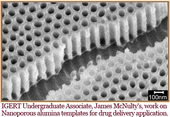Highlight
Associates Research Projects Highlights
Achievement/Results
Northeastern University has established an Integrative Graduate Education and Research Traineeship (IGERT) Nanomedicine Science and Technology Program with funding from the National Science Foundation (NSF) and National Cancer Institute (NCI). A successful Associates Program has also been developed to encourage undergraduate research and to create a pipeline for undergraduates to enter graduate program in nanomedicine.
Address Goals
Undergraduate students with a keen research interest in science and engineering fields work in a research laboratory for a period of four to six months. Students work on various nanomedicine-related projects and make significant contributions to the research efforts to the lab in which they work. Results of their research have been presented at various national and international conferences.
Highlights from some of the undergraduate student research are detailed below.
IGERT Undergraduate student: James McNulty Advisor: Dr. Srinivas Sridhar Project Title: Nanoporous alumina templates for drug delivery applications Nanoporous alumina templates can be created with precise control on pore size, interpore distance and thickness. These templates can be incorporated on implant surfaces. Within these pores, drug molecules can be filled and upon release can be used as a localized drug delivery system. James worked in Dr. Sridhar’s laboratory to optimize the experimental conditions needed to obtain uniform controlled porous surfaces.
James coauthored a presentation at the March American Physics Society Meeting (March 10-14) at New Orleans, 2008.
IGERT Undergradute student: Robin Ortiz Advisor: Dr. Barbara Waszczak Project Title: Intranasal Delivery of GDNF Using Cationic Liposomes Robin’s research involved the use of cationic liposomes for intranasal delivery of Glial cell line-derived neurotrophic factor (GDNF) in brain as a novel treatment for Parkinson’s disease. Conventional delivery of GDNF is not safe and this approach offers a more effective method in delivery and hence better treatment option.
Robin’s work was showcased at Society for Neuroscience Convention at San Diego, CA, 11/05/2007.






